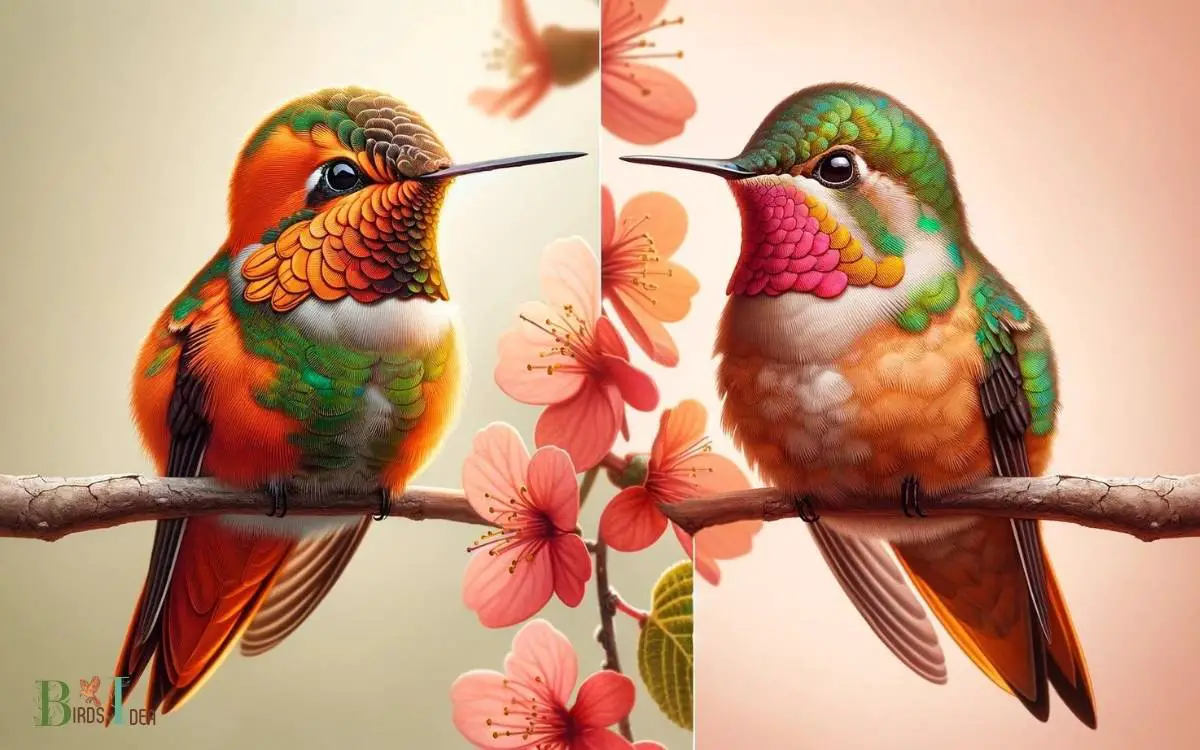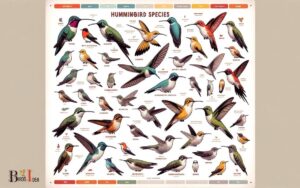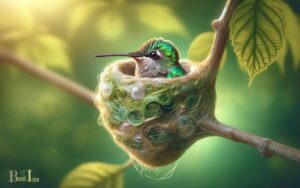Rufous Hummingbird Male Vs Female: Comparison!
The Rufous Hummingbird (Selasphorus rufus) is a small bird known for its remarkable migratory pattern and distinct sexual dimorphism.
Male Rufous Hummingbirds exhibit a brilliant orange on their backs and bellies with a signature iridescent red throat patch or gorget.
Females, on the other hand, have a more subdued appearance with greenish upper parts, speckled throats, and white-tipped outer tail feathers.
Sexual dimorphism is a biological term used to describe the differences in appearance between males and females of the same species. In Rufous Hummingbirds, this dimorphism is evident.
Here’s a quick comparison:
During the breeding season, males use their colorful plumage and acrobatic flight displays to attract females.
The female Rufous Hummingbird is responsible for building the nest and caring for the offspring.
In both sexes, their small size and rapid wingbeats allow them to hover in place and skillfully maneuver while feeding on nectar from flowers and small insects.
Distinctly different in plumage, the male Rufous Hummingbird’s fiery feathers are a stark contrast to the more camouflaged tones of the female, showcasing nature’s flair for diversity.

Key Takeaway
Physical Differences
The physical differences between male and female Rufous Hummingbirds are most notably observed in their plumage colors and patterns.
Male Rufous Hummingbirds exhibit vibrant and iridescent orange-red plumage on their throats, known as the gorget, and their upperparts are a mix of coppery-red and green.
In contrast, female Rufous Hummingbirds have green upperparts with a speckling of reddish-brown, and their throats lack the brilliant orange-red gorget seen in males.
These distinct plumage variations serve important purposes in courtship and mating rituals, as well as in providing camouflage and protection during nesting and foraging activities.
Understanding these physical differences in plumage is crucial for accurately identifying and studying these fascinating birds in their natural habitats.
Plumage Variation
The plumage variation between male and female Rufous Hummingbirds is a subject of interest due to the striking differences in coloration.
Understanding the color differences in plumage can provide valuable insights into the behavior and ecology of these birds.
Additionally, the molt and seasonal changes in plumage play a crucial role in the life cycle of Rufous Hummingbirds, influencing their breeding and migration patterns.
Color Differences in Plumage
Coloration differences in plumage between male and female Rufous Hummingbirds are notable and serve as important markers for distinguishing between the sexes.
- The male Rufous Hummingbird typically exhibits bright and vibrant plumage with iridescent orange-red throat patches, green back feathers, and white underparts.
- These colors play a crucial role in courtship displays and are linked to mate selection and competition for resources.
- In contrast, the female Rufous Hummingbird showcases more subdued plumage with greenish-gold iridescent feathers on the back and a pale, speckled throat.
- This coloration provides effective camouflage during nesting and incubation, offering protection from potential predators.
Understanding these color differences in plumage is essential for accurately identifying and studying male and female Rufous Hummingbirds in their natural habitat.
Molt and Seasonal Changes
During molt and seasonal changes, the plumage of male and female Rufous Hummingbirds undergoes distinct transformations, contributing to their visual appearance and ecological roles.
The plumage variations are important for their survival, reproductive success, and social interactions.
The following table summarizes the key differences in the plumage of male and female Rufous Hummingbirds during different seasons:
| Season | Male Plumage | Female Plumage |
|---|---|---|
| Breeding | Brilliant iridescent orange-red throat, white breast, green back | Green back, rufous sides, white breast |
| Migration | Duller throat, orange-red spots on sides | Green back, rufous sides, white breast |
| Winter | Dull throat with some orange-red spots | Green back, rufous sides, white breast |
These seasonal variations in plumage play a crucial role in the mating behavior and ecological adaptation of Rufous Hummingbirds.
Behavioral Implications of Plumage
As plumage variation plays a significant role in behavioral patterns, it is essential to understand the implications of these differences in male and female Rufous Hummingbirds.
Male Plumage Implications:
- Bright, iridescent plumage serves as a signal of male quality and dominance.
- Aggressive behavior is often associated with defending territories and attracting mates.
Female Plumage Implications:
- Subdued plumage aids in camouflaging during nesting and incubation.
- Less conspicuous colors reduce the risk of predation while foraging and caring for young.
Understanding these behavioral implications provides insight into the evolutionary and ecological strategies of male and female Rufous Hummingbirds.
It also sheds light on the intricate interplay between plumage variation, reproductive success, and survival in these remarkable avian species.
Behavioral Variances
The behavioral variances between male and female Rufous Hummingbirds can be observed in their foraging patterns and territorial behaviors.
Male Rufous Hummingbirds tend to have more extensive foraging territories and are more aggressive in defending them compared to females.
On the other hand, female Rufous Hummingbirds have smaller foraging territories and are less aggressive in defending them.
These behavioral differences can be attributed to the reproductive roles of each gender, with males needing to defend larger territories to attract mates, while females focus on nesting and caring for their young.
The following table summarizes the behavioral variances between male and female Rufous Hummingbirds:
| Behavior | Male Rufous Hummingbirds | Female Rufous Hummingbirds |
|---|---|---|
| Foraging Territory | Larger territories | Smaller territories |
| Territorial Defense | More aggressive | Less aggressive |
Mating and Courtship
The mating and courtship behaviors of Rufous Hummingbirds are fascinating to observe. Male courtship displays and female mate selection are key aspects of their reproductive behavior.
Understanding these behaviors can provide valuable insights into the evolutionary strategies and ecological dynamics of these remarkable birds.
Male Courtship Displays
Male Rufous hummingbirds exhibit elaborate courtship displays to attract females during mating and courtship.
- These displays involve intricate aerial maneuvers such as steep dives, U-shaped flights, and pendulum-like arcs.
- The steep dives are accompanied by high-pitched vocal sounds produced by the male’s tail feathers.
- The U-shaped flights are designed to showcase the iridescent throat patch, or gorget, to the female.
These displays are crucial in signaling the male’s fitness and genetic quality to potential mates. The agility and speed demonstrated during these displays serve as indicators of the male’s ability to provide good genes and protection for the female and her offspring.
By understanding these courtship displays, researchers gain insights into the evolutionary pressures that have shaped the mating behaviors of Rufous hummingbirds.
Female Mate Selection
When observing courtship displays, female Rufous hummingbirds carefully evaluate potential mates for their agility, speed, and genetic quality before making a selection.
The females pay close attention to the males’ aerial displays, assessing their maneuverability and speed, which are indicative of their fitness and vigor.
Studies have shown that female Rufous hummingbirds are selective in their mate choice, often preferring males with more vibrant plumage and those that exhibit consistently vigorous and complex courtship displays.
Additionally, genetic compatibility seems to play a crucial role in the female’s decision-making process. Females seek out males with genetic diversity to ensure healthier and more robust offspring.
This selective process ensures that the chosen mate will contribute desirable genetic material to the offspring. Such discerning behaviors contribute to the reproductive success and genetic diversity of the species.
Nesting and Parenting
Nesting and parenting behavior in rufous hummingbirds involves the construction of small, cup-shaped nests and the shared responsibility of incubating and feeding the young.
The female rufous hummingbird meticulously selects a nesting site, often choosing a location with protective overhangs to shield the nest from the elements and potential predators.
The male contributes to the parenting process by defending the nesting territory and providing essential resources for the female and the offspring.
Both parents actively participate in raising the young, with the female primarily responsible for incubation while the male assists in feeding and protecting the nest.
This cooperative effort ensures the survival and well-being of the offspring, a remarkable example of parental investment in this species.
This cooperative nesting and parenting behavior has significant ecological implications for the survival and population dynamics of rufous hummingbirds.
Ecological Implications
The cooperative nesting and parenting behavior of rufous hummingbirds has significant ecological implications for their survival and population dynamics.
These implications are rooted in the impact of their behavior on ecosystem dynamics, plant pollination, and insect control.
The table below outlines the ecological implications of the rufous hummingbirds’ nesting and parenting behavior.
| Ecological Implications | Description |
|---|---|
| Ecosystem Dynamics | Rufous hummingbirds contribute to the health and diversity of ecosystems through pollination. |
| Plant Pollination | Their foraging behavior aids in the pollination of various plant species, supporting plant diversity. |
| Insect Control | By consuming insects, they contribute to controlling insect populations, thereby impacting ecosystem balance. |
| Biodiversity Maintenance | Through their foraging and nesting activities, rufous hummingbirds play a role in maintaining biodiversity within their habitats. |
Conclusion
The rufous hummingbird displays notable physical, behavioral, and ecological differences between males and females.
One interesting statistic is that male rufous hummingbirds are often slightly larger and more brightly colored than females, which may play a role in their mating and courtship behaviors.
These variations in appearance and behavior contribute to the complex dynamics of the species and highlight the importance of understanding gender differences in ecological studies.






